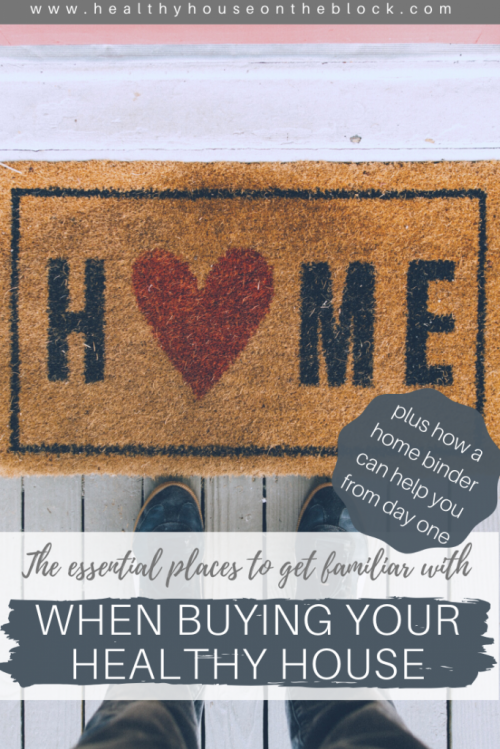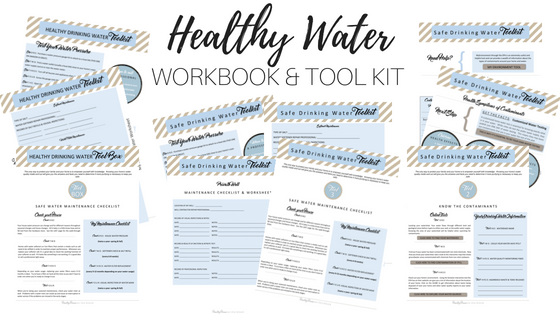
How familiar are you with your ENTIRE healthy house? I mean even the utility room, attic, crawl space and exterior?
Most of us are aware it exists, but don’t necessarily know what to look for in these spaces.
But doesn’t that make sense? Did you ever take a class that explained how to take care of a home?
And even if your inspector or realtor DID tell you what to watch for, it often feels a little ambiguous and certainly does not seem like a clear cut checklist.
And again, this makes sense. Our homes are all unique and different depending on the age, style, builder and climate around our home.
What you need is to create your OWN checklist and plan for your home to know what to watch for and what ways you can improve your home to reduce toxins inside.
Come along with me this week as we talk about how to get familiar with your home and how you can use my home binder printable to create a way to maintain and care for your home in a healthier way.
One of the best parts of my job is getting to help someone learn about their new or current house. I love being able to show them how to take care of their space and what they can do to make it healthier. I also love helping them put together a home binder that they can use to maximize their home’s health.
All of that starts with really knowing your house and just familiarizing yourself with how it works, what the idiosyncrasies are and how to approach the challenges that may come with your home.
While I generally do my walk through one-on-one and in person, I thought it would be fun to show you exactly how I familiarize myself with each home I’m in. It’s an important step in being a homeowner, and it can really help you with the health of your home in the long run.
The great thing is it really doesn’t take a lot of time. Instead, it takes a lot of paying attention and knowing what to look for, which is exactly what we’re going to talk about today. Knowing what’s going on with your house is half the battle in making it a healthy space for your family.
I’ve also created a checklist (for a home binder or to use alone) for you that will guide you through your home so nothing gets missed. This is the same type of checklist that I use in going through each of my clients’ homes, so it’s chock full of forgotten spaces and items we don’t always remember to look at.
WHY IT’S IMPORTANT
The standard of a healthy house is one that has fewer toxins, fresh air and the perfect humidity levels. All of these points can be changed by a multitude of different factors within your house and by your daily habits. (This is how a home binder can help keep track of these important tasks, which I’ll get into more later)
The more familiar you are with every area and space of your home, the easier it becomes to understand HOW you can maintain its health, or how you can improve it.
Another reason it’s so important to know the ins and outs of your house is to prevent unforeseen pitfalls. When you’re not aware of every area, you can completely miss a potential problem or issue before it’s too late.
The thing with houses is that often the systems and components of your home are affected by other systems and components. For example a leak isn’t merely about fixing the plumbing, but it will also require repairs to drywall as well as in turn figuring out how to lower the indoor humidity.
Nothing operates in a vacuum within our homes, and so it’s important to understand how each system contributes to the health of our home and how to be aware of what’s going on.

IF YOU’RE BUYING A NEW HOME
The best way to familiarize yourself with your new home is to get an inspection done. And not only that, but attend the inspection and feel free to tag along with your inspector. They can show you things about your house you likely haven’t thought of before. An inspection is an invaluable tool when it comes to buying a house. It’s like a crash course on your specific house. All homes are different, but when an inspector is in your home, everything is relevant to yours.
Take pictures, notes and videos of any advice your inspector is offering in terms of maintenance or repairs. An inspection can be incredibly overwhelming and it can be impossible to remember everything you’re told or shown.
The inspection report can also be a useful tool. It will be able to tell you what your material your water pipes are, the model and serial number of your furnace and how old your roof may be. Keep a file folder with your report and any of your notes handy. When you’re in need of that information, you’ll want to be able to find it right away.
Creating a home binder right away with pertinent information, or keeping your home inspection for reference can be on the best tools as you begin to take care of your new house.

IF YOU’VE LIVED IN YOUR HOME FOR A WHILE
If you’ve been in your home for a while, it doesn’t mean that you can’t have an inspector walk through. Although this isn’t a common ask, I have done it with several clients who needed some peace of mind.
Other ways you can get familiar with your house would be to look through the original inspection document from your property. If you don’t have it or didn’t get one, there are other ways, but this is the first and best way.
Anytime you end up calling a company to repair or update your home, make sure you ask them questions about the area they’ll be working in. These contractors and trades people are often extremely knowledgeable and can offer tips and advice on whatever they’re working on.
I, myself, have done this exact thing with our chimney sweeper and the company who re-sided our home. While I felt pretty confident in my knowledge of these areas, I knew they held so much more knowledge and could give me some great advice.
Finally, you can download my guide and checklist to help you familiarize yourself with your home. It can help to have a home binder to keep all of the valuable information accumulated over time. The more you know, the healthier it can be.
THE IMPORTANT AREAS TO BE COMFORTABLE WITH IN YOUR HEALTHY HOME
Utility Room: Understanding WHY something may make a funny noise or how to fix a minor issue can be a HUGE part of maintaining your appliances and systems. Make sure you’re familiar with your water heater and that you understand the maintenance that’s required. Water and water quality is a huge part of a healthy house, and maintaining your water heater is going to help maintain your water quality.
It’s also important to understand your heating and cooling systems. These can have leaks that pop up from time to time, and often, they’re minor in nature. But being familiar with your utility room and visiting it often is a good way to catch any problems before they get too big.
Use your knowledge here as an advantage. The next time you have to go to the hardware store or you have to call a repair technician, you’ll be able to answer any questions they might have about your systems. This way they can be a better help to you.
Laundry Room: It’s important to know where water is being discharged in your laundry room and if you have any sort of venting to keep humidity levels low. These are really important things to know in a laundry room, as well as the age of your washing machine.
You can visit homespy.io and input your model and serial number of your laundry appliances (often found in the door). It will help you date the appliances so you know what kind of life is left in them.

Garage: The garage is a place that I have to admit, I’m not the best about visiting and keeping tabs on. It’s not really easy to see every corner, it’s dirty and it’s cluttered with kids’ toys and tools. This doesn’t make it my first spot to peek around. But, it is still really important to be familiar with your garage.
The more familiar you are with the space and the more comfortable you are, the more you’ll catch any sort of problem that might be brewing. Look for small holes that moisture or rodents can get in. These two issues can wreak havoc on a healthy house and cause a lot of problems down the road.
Be aware of the foundation in your garage too — watch for crumbling, cracks or major settling. It’s important to uncover some areas every now and then so you can see what’s going on. It might mean moving a workbench out a bit to peek at the wall or sliding out a shoe shelf to make sure nothing’s going on behind it.
Foundation & Basement: This is a big one. Especially if you live in a part of the country where your home has a full basement. Basements are usually not our first stop, but it’s important to know what’s going on with them. You should be able to tell if your basement is more humid than normal or if it has a musty smell.
It’s also important to look at the foundation walls to make sure they aren’t damp, cracked or severely shifting. If your basement is a finished space, it might be tricky to detect these things, but you can still feel the walls to make sure they aren’t soft. You can also look around with a flashlight in every corner and covered area to make sure you don’t spot any water damage.
A home that has a humid basement can potentially have a problem with mold, humid indoor air or structural problems.
Attic: This isn’t one I recommend visiting ALL the time, but once a year, make it a habit for someone in your house to shine a flashlight into your attic and look around. Check the sheathing (underside of the roof) for water damage or leaks. It’s also a good idea to check the insulation to make sure there aren’t any rodents that have made their home burrowing in the soft material.
This will help you know if you have an area of your exterior that needs to be sealed or repaired BEFORE it becomes a BIG problem.
Exterior: In the fall and spring, make it a habit to walk around your house. Get to know what your soil around your house looks like. This way, you’ll be able to tell if at any point the grade is negative and allowing moisture to seep back in towards your foundation.
It’s also a good idea to just look at windows and siding to make sure there aren’t any areas that are compromised. It’s amazing what you can catch when you’re just doing a visual walk through.
Using the checklist I have will help you know just what to get familiar with and what to keep track of on the outside of your house as well as the inside. You can read more about how home maintenance on the exterior can help your healthy house.
ESSENTIALS FOR A HOME BINDER (MY GUIDE & CHECKLIST)
Are you like me in the sense that a checklist and written out to-do sheet is a necessary step to getting anything done? I’m so excited to share with you this checklist to help you familiarize yourself with your own home. It’s a good way to keep track of the areas that often get forgotten about.
This home binder printable is perfect to keep handy as you can record some vital information about your home, systems and appliances in it. Keeping track of each and every system of your house will help you when it comes time to improve your home to make it healthier.
ADDITIONAL PRINTABLES FOR YOUR HOME BINDER
Share this:
- Click to share on Facebook (Opens in new window) Facebook
- Click to share on LinkedIn (Opens in new window) LinkedIn
- Click to share on Reddit (Opens in new window) Reddit
- Click to share on Pinterest (Opens in new window) Pinterest
- Click to print (Opens in new window) Print
- Click to share on X (Opens in new window) X















Although I live in an Asian home, these tips are still very useful to my life. I will share this to my family and friends.
What a wonderful idea! I’ve had a binder for preparedness purposes but I’ve never thought about keeping a binder for tracking other household items. Your other resources look really interesting! Can you give me an example of what might be in your seasonal checklists – maybe one or two examples?
Thanks for great tips, very much apprecialted